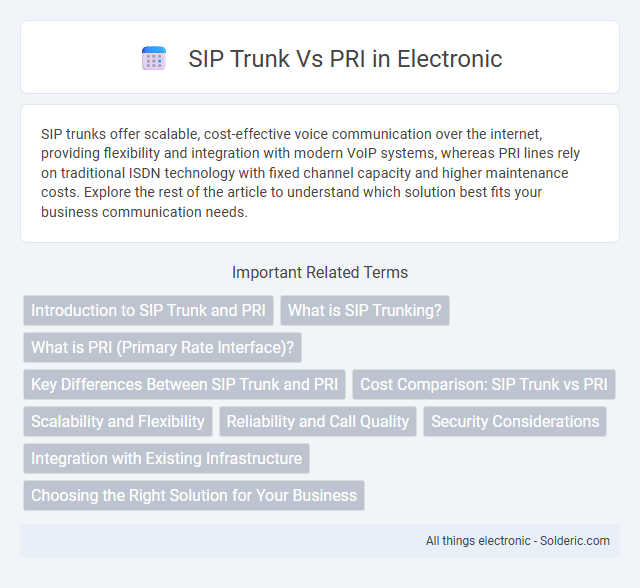SIP trunks offer scalable, cost-effective voice communication over the internet, providing flexibility and integration with modern VoIP systems, whereas PRI lines rely on traditional ISDN technology with fixed channel capacity and higher maintenance costs. Explore the rest of the article to understand which solution best fits your business communication needs.
Comparison Table
| Feature | SIP Trunk | PRI (Primary Rate Interface) |
|---|---|---|
| Technology | Internet Protocol (VoIP) | T1/E1 digital circuit |
| Channels | Scalable, based on bandwidth | 23 channels (T1) / 30 channels (E1) |
| Cost | Lower monthly fees, pay for bandwidth | Higher fixed monthly cost per channel |
| Flexibility | Highly flexible, quick scaling | Limited, fixed number of channels |
| Infrastructure | Uses existing IP network | Requires dedicated physical lines |
| Installation Time | Faster, software-configured | Longer, physical setup needed |
| Quality of Service | Depends on internet quality and QoS settings | Consistently high, circuit-switched |
| Compatibility | Works with IP-PBX and modern networks | Supports traditional PBX and legacy systems |
| Reliability | Good, with backup internet options | Very high, dedicated circuit |
Introduction to SIP Trunk and PRI
SIP Trunk and PRI are two essential technologies for business telephony systems, each serving as a method to connect your phone system to the public switched telephone network (PSTN). SIP Trunk uses internet protocol (IP) to transmit voice and data, offering flexibility, scalability, and cost savings by leveraging your existing internet connection. PRI (Primary Rate Interface) is a traditional T1 line technology providing dedicated channels for voice calls, known for its reliability and consistent call quality in conventional telephony infrastructure.
What is SIP Trunking?
SIP trunking is a method of delivering voice and multimedia communication over the internet using the Session Initiation Protocol (SIP), eliminating the need for traditional physical phone lines. It allows businesses to connect their private branch exchange (PBX) to the internet, enabling cost-effective, scalable, and flexible communication. You can significantly reduce telephony expenses and improve call management by choosing SIP trunking over PRI (Primary Rate Interface).
What is PRI (Primary Rate Interface)?
Primary Rate Interface (PRI) is a telecommunications standard used in Integrated Services Digital Network (ISDN) systems to provide high-capacity voice and data transmission services. It consists of 23 bearer channels (B-channels) for voice or data and one data channel (D-channel) for signaling in North America and Japan, aligning with the T1 standard, while in Europe and other regions it uses 30 B-channels and one D-channel based on the E1 standard. PRI enables reliable, dedicated circuit-switched connections essential for large-scale businesses requiring consistent call quality and capacity.
Key Differences Between SIP Trunk and PRI
SIP Trunk uses Internet Protocol (IP) to enable voice and multimedia communication, offering scalable and cost-effective connectivity through virtual channels, whereas PRI relies on traditional T1 or E1 circuits delivering fixed-channel physical lines. SIP Trunk supports flexible channel allocation based on demand, while PRI provides a fixed number of 23 (T1) or 30 (E1) simultaneous voice channels. SIP Trunk integration with VoIP systems enables advanced features like unified communications and cloud-based services, contrasting PRI's dependence on legacy telephony infrastructure.
Cost Comparison: SIP Trunk vs PRI
SIP trunking offers significant cost savings over PRI by eliminating the need for physical phone lines and reducing long-distance charges through internet usage. PRI lines typically incur higher installation and monthly fees, including charges for each channel, while SIP trunks provide scalable channels at a lower per-channel cost. Organizations adopting SIP trunks benefit from flexible, usage-based pricing models, leading to reduced capital expenditure compared to the fixed costs of PRI infrastructure.
Scalability and Flexibility
SIP trunking offers greater scalability than PRI by allowing businesses to easily adjust the number of concurrent calls without physical line limitations, supporting rapid growth and fluctuating call volumes. Flexibility is enhanced with SIP trunks through integration with VoIP systems and cloud services, enabling seamless deployment across multiple locations and devices. In contrast, PRI requires fixed channels and physical circuits, limiting adaptability and making expansions more costly and time-consuming.
Reliability and Call Quality
SIP trunks offer high reliability through internet-based protocols with robust failover options, ensuring minimal downtime for your communication system. PRI connections maintain consistent call quality using dedicated circuits, reducing latency and jitter often experienced in IP networks. For businesses prioritizing dependable call quality and system uptime, choosing between SIP trunk and PRI depends on infrastructure and specific needs.
Security Considerations
SIP trunk security involves encryption protocols such as TLS and SRTP to protect voice data from interception and fraud, while incorporating firewalls and session border controllers to prevent unauthorized access. PRI offers a dedicated physical connection, reducing risk of data breaches due to its circuit-switched nature, though it lacks inherent encryption and requires robust network perimeter controls for security. Organizations must evaluate their security infrastructure, considering SIP trunks' susceptibility to cyber threats versus PRI's physical line security constraints when selecting VoIP connectivity options.
Integration with Existing Infrastructure
SIP trunk integration with existing infrastructure leverages IP-based networks, allowing seamless connection to VoIP systems and enabling scalable and flexible communication solutions without the need for extensive hardware modifications. PRI relies on traditional T1/E1 lines, requiring physical PBX compatibility and potential upgrades for integration, which can limit adaptability and increase setup complexity. Your decision will depend on whether your current infrastructure supports IP technology for smoother SIP trunk deployment or if it necessitates the legacy circuit-based approach provided by PRI.
Choosing the Right Solution for Your Business
Choosing the right solution for your business depends on factors such as scalability, cost, and call quality. SIP trunking offers greater flexibility and lower operational expenses by using internet connections, while PRI provides a more stable and dedicated line with guaranteed call quality for high-volume voice traffic. Understanding your organization's current and future communication needs will help you determine whether SIP trunks or PRI lines best support your business growth and reliability requirements.
SIP trunk vs PRI Infographic

 solderic.com
solderic.com